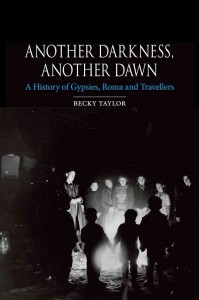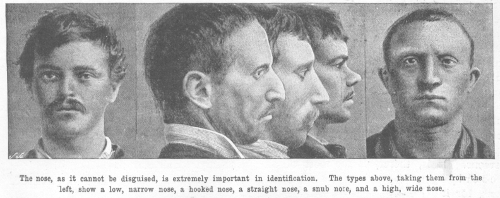Review: Another Darkness, Another Dawn: A History of Gypsies, Roma and Travellers by Becky Taylor Reaktion Books (2014)
Becky Taylor’s book covers a lot of ground. Stretching from the movement out of India around 500 CE (according to genetic evidence) to the varied experiences of those latterly labled Gypsies and Travellers as they arrived in Europe. The book, rather than relying on heavy handed use of fashionable theorists, lets the experiences of Gypsies, Roma & Travellers speak for themselves – with apposite quotes from them throughout. Use of wide-ranging archival sources in several languages enables Taylor to give us a rounded picture.
Given the centrality of movement, both of people and borders to the story at hand, it would have been helpful to have more maps than the one provided.
Unsurprisingly, given the experiences of Gypsy’s in Europe the book is often distressing to read – a litany of persecution, prejudice and murder. However, it is far more than this – and Taylor is careful not to generalise, nor reduce their experiences to mere suffering. Indeed, one of the strengths of the book is that it covers their experiences under a number of regimes from the the Ottoman and Venetian empires to the Soviet and Nazi regimes to the modern day ‘liberal’ and not-so-liberal states – and the way that Gypsy’s were able to survive – and in some instances thrive.
It is also a history of “othering” – a strong part of the Gypsy identity has always been their “foreignness” (1). It was on entering Western Europe on the 15th Century that they became known as “Egyptians”- one source suggested that that is where they stated they originated themselves to be from – but it is equally likely that there”Moorish” appearance suggested to the European that they must be from Africa.
The book is also primer on the growth of social control – and the wider growth of the ambition and power of the state to shape people’s lives. Attempted control of poor people’s movement far pre-dated In/Out migration controls – and Gypsies were the pre-eminent target of the developing States’ experiments in social control.
Even while national boundaries were largely uncontrolled – those labelled as “Tsigane”, “Gitano”, “Bohemians”, “didikais”, “Zigunermischlings”and “Gyptians” were required needed permits to travel and trade even within them.
In the pre-modern state Roma’ were often the subject of forced labour – enslavement of varying degrees; thus their contemporary association with Modern Day Slavery obscures their far more substantive historical connection as victims of slavery – a useful tool for amenesiac society.
As we move nearer to the era of the modern state the subject of a number of racist laws – for instance ”The territories of The Holy Roman Empire passed 133 anti-gypsy measures in the years 1551-1774”(2). Hideous and grotesque laws such as legalisation condoning the killing of gypsies- and in Germany the occurrence of “Gypsy Hunts” (3) in the 16th to 18th centuries.
However, despite these and many other similarly drastic laws and proclamations the ability of the state and willingness of local administrators to carry them out was extremely limited. Deportations – perhaps a defining feature of the contemporary punitive nation state – were also carried out – though ineffectively – for there were no camps or prisons to contain them in – yet. Taylor underscores this point – the ambitions of the pre-modern state to control were often confounded by their lack of ability to do so.
Unfortunately, the fragmented and weak powers of the old European empires were replaced by the coming of the modern nation State which began to assert a total monopoly of authority within their self-defining boundaries. This, combined with the new racial ‘science’ of the 19th Century proved most deadly for it’s Travelling population, as it did for other minorities. There is compelling evidence within the history of the nation state for suggesting that rather than being a ‘break’ or ‘fissure’ in European history the genocide of Gypsies and Roma (as with other victims) is a on a continuum(4).
Evidence for this is plentiful. but one example linkking 19th Century ideas to 20th Century genocide is “Anthropometric measurement”. Invented by a Frenchman Alphonse Bertillon in 1883, it was already being employed by French police by the end of the 19th century as a method of surveillance. It used various measurements of the human body including: “height, stretch (as defined by the length of the body from left shoulder to right middle finger), bust (as defined by the length of one’s torso from the head to the seat, when seated), head width (measured from temple to temple)…” (5) and so on. It’s purpose was two-fold; to identify individual recidivist criminals for future conviction (a forerunner of fingerprints) ; and more sinisterly to identify physical features supposedly common in criminal or deviant types.
While for the general population only convicted criminals were recorded in this way, from 1912 all nomades or gypsies were measured. They were issued with a ID card containing this information which they had to present at the police station each time they entered a departement(6) or face punishment. This was used to stop Gypsies stopping in the area, but also to enforce further requirements which were only demanded of Gypsies – relating to hygiene and as well as bizarrely to vehicle maintenance.
Unsurprisingly, the Nazis themselves utilised anthropometric methodology – and used the records the French had already collected after the invasion to help round-up Gypsies to the camps. This is probably one of the best arguments against centralised databases in history.
However, even before the Nazis had occupied France, Gypsies had started to be interned in camps in 1940 – which again the Nazis and the new Vichy regime found very convenient.
A estimated 250,000 Roma died during the holocaust.
Perhaps the most distressing part of the book is the fact that Gypsies were continued to held in camps post-WWII – the events of the immediate past unrecognised by Germany. The Nuremberg trials “barely mentioned Roma and Sinti in their considerations”(7). Not only that, rather than an a apology or compensation the mass murder and internment was instead rationalised in the years after the war: “Gypsies and gypsies of mixed race…[have] not been persecuted and imprisoned for racists reasons, but rather because of their asocial and criminal attitude”(8).
A civil rights movement inspired, as many others were by the African-American one in the US, for the first time, Roma and Gypsy led organisations, independent of government raised their voices. However, this couldn’t stop the consensus of Cold War-era policies which“…were remarkably similar on both sides of the Iron Curtain that promoted.“… policies pushing settlement and assimilation…”(9).
Taylor focuses on the persecution of Roma in France in her afterwood to demonstrate that persucution of Gypsys, Roma and Travellers continues to this day; the forced evictions and state prejudice marked by a special task force and database for “travelling crime” and criminals.
Sadly, Taylor could have chosen numerous other examples from across Europe to illustrate her point; The eviction of Dale Farm, the everyday prejudice Roma face in the Czech Republic, the demolition of their homes in Bulgaria…the list could go on.
The quote from which the book under review takes it’s title from perhaps sums it up most eloquently:
“It’s the end of the war, we’ve survived. After the darkness, comes the dawn. But also after dawn comes the darkness. Who knows what’s in store for us.”
Ilona Lackova, Writer, Slovakian Roma and Holocaust Survivor.
References
(From the book under review unless otherwise stated).
(1) pp14
(2) pp65
(3) As antediluvian as they sound , are Gypsy Hunt’s differ that much from the EU wide migrant hunts – such as operation Mos Maiorum which took place this year? http://statewatch.org/news/2015/jan/mm-final-report.html
(4) A point that Mark Mazower makes in his short, bloody history of Europes 20th Century “Dark Continent” (1998).
(5) Wikipedia contributors, “History of anthropometry,” Wikipedia, The Free Encyclopedia, http://en.wikipedia.org/w/index.php?title=History_of_anthropometry&oldid=647277568 (accessed February 22, 2015).
(6) pp152
(7) pp190
(8) pp190
(9)pp188


